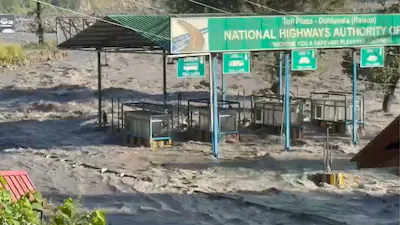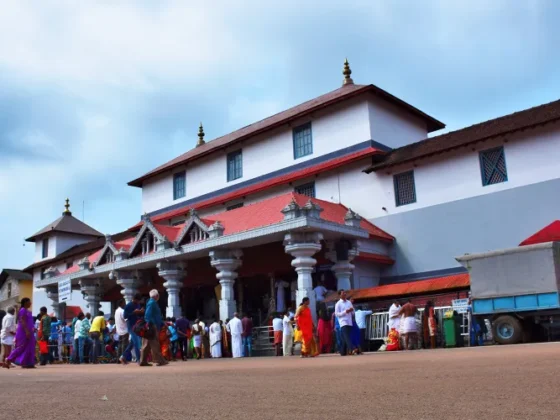The relentless monsoon rains have once again triggered chaos in Himachal Pradesh. The mighty Beas River, swollen by continuous downpours, has spilled over its banks and flooded the Raison Toll Plaza near Manali. In dramatic visuals that went viral, the river can be seen gushing through the toll gates, turning a key highway checkpoint into a raging waterway.
Beas River Turns Into a Menacing Force
The Beas River, normally a lifeline of the region, has transformed into a destructive torrent. Its waters have surged into highways and villages, submerging infrastructure and sweeping away anything in their path. At the Raison Toll Plaza, the floodwaters rose high enough to completely submerge toll booths, halting traffic and cutting off connectivity on the busy Chandigarh–Manali and Manali–Leh highways. Officials have reported that over 250 roads across the state are currently blocked due to flash floods and landslides.
Highways Cut Off, Vehicles Swept Away
The flooding has left several stretches of the highways badly damaged or washed away. A pickup truck was caught on camera being swept away within seconds after the road collapsed beneath it. In Kullu and Mandi districts, more than 1,200 vehicles remain stranded, and National Highways Authority of India (NHAI) teams are working round-the-clock to restore connectivity. Initial estimates suggest that road damage could run into hundreds of crores of rupees, given the scale of destruction.
Manali’s Iconic Structures Hit
The destruction hasn’t spared landmarks either. The popular Sher-e-Punjab restaurant in Manali, a go-to stop for tourists, was almost completely destroyed by the overflowing river, leaving only fragments of its walls standing. Several hotels along the Beas have been washed away, and in Kullu, at least 50 shops and houses have been severely damaged or lost entirely. Locals fear that the losses to the hospitality sector alone may cross ₹500 crore, given that the peak tourist season has been completely disrupted.
Pilgrimage Suspended, Thousands Stranded
The situation has had spiritual and social consequences too. The famous Manimahesh Yatra pilgrimage has been suspended due to blocked routes and unsafe conditions. Reports indicate that over 5,000 pilgrims and tourists are stranded across Himachal Pradesh, with evacuation efforts underway. State authorities, supported by the Indian Army and disaster response forces, have already rescued nearly 2,000 people by airlifts and ground operations.
Statewide Havoc and Rescue Efforts
Across Himachal Pradesh, 13 major bridges have been washed away, power lines have snapped, and water supply systems have collapsed in several districts. The Himachal Pradesh State Disaster Management Authority has confirmed at least 15 fatalities and dozens of injuries linked to landslides and flooding. Relief camps have been set up in Kullu, Mandi, and Kangra to shelter displaced families. The central government has released an immediate relief package of ₹300 crore, with promises of further support.
Nature’s Wrath and a Warning
The Beas River’s fury is a stark reminder of the growing vulnerability of Himalayan states to extreme weather events. Experts have long warned about the combined impact of climate change, unchecked urbanization, and deforestation on the fragile mountain ecology. This year alone, Himachal Pradesh has received 45% excess rainfall compared to the seasonal average, leading to frequent cloudbursts and flash floods. The current crisis is yet another call for better disaster preparedness, stricter zoning laws, and sustainable development in the region.
Conclusion
As the images of the Beas River swallowing toll plazas and washing away iconic landmarks spread nationwide, they underscore both the fury of nature and the fragility of human infrastructure in the mountains. Himachal Pradesh now faces the twin challenge of rescuing the stranded and rebuilding the destroyed—a task that will require both immediate relief and long-term resilience planning.
FOR MORE BLOGS – beyondthepunchlines.com

 Add to favorites
Add to favorites








